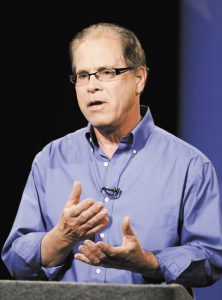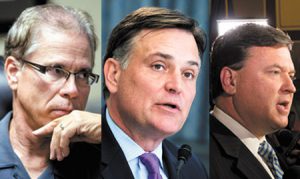
Secretive PACs key source of funds in U.S. Senate race
The money flowing into a competitive U.S. Senate race can weave an intricate web of sources.

The money flowing into a competitive U.S. Senate race can weave an intricate web of sources.
Republican U.S. Senate candidate Mike Braun continues to pump his own money into his campaign, and appears to be engaging in the controversial but legal practice of using donations for retiring debt from his primary race to boost his general election campaign.

The 64-year-old Republican told IBJ that he hasn’t made a formal announcement, but he has been telling anyone who asks him that he will run again.

Political strategists say it’s not surprising: The candidates and outside groups could spend more than $100 million on the Senate race, which makes self-funding extremely difficult.
But political experts say a Trump-centered strategy might not be the best move now that Mike Braun has won the GOP primary race and will face Democratic Sen. Joe Donnelly in the fall election.

Three Republican challengers and the incumbent Democrat have raised nearly $22 million and spent nearly $14 million.

U.S. Senate Republican candidate Mike Braun also has the most cash on hand going into the final weeks of the campaign, although most of the funding is coming from himself.

Carmel philanthropists and sisters Deborah Simon and Cindy Simon Skjodt have become big-time campaign donors this election cycle.

It’s going to be ugly and expensive. That’s the message political experts are sharing about the Republican primary that will decide who will challenge Democratic U.S. Sen. Joe Donnelly in the fall.
Indiana Sen. Joe Donnelly’s reelection campaign raised $1.2 million during the last three months of 2017. Prominent Democrats are hosting fundraisers and stumping for the vulnerable, red-state candidate.
U.S. Sen. Joe Donnelly of Indiana is holding strong against would-be challengers when it comes to fundraising ahead of what’s sure to be a competitive 2018 race.
Indiana Gov. Eric Holcomb has started a new political action committee to raise money for his campaign committee and the state Republican Party.
Democrats thought Indiana’s 9th district would be competitive in 2016, but Rep. Trey Hollingsworth won the election by 14 percentage points. Progressives think they’ll have a much better shot in 2018, especially if President Donald Trump stumbles.
Indiana's former governor launched Great America Committee, a leadership PAC, a move that will enable him to channel money to congressional Republicans ahead of the 2018 midterm elections.
Large political advocacy groups have emerged as the top donors in the Indiana gubernatorial race, far outpacing the size of donations from individuals.
A Democratic Super PAC is swooping in to help Democratic U.S. Senate candidate Evan Bayh as Republican Todd Young taps some GOP heavyweights to make the case for his election. While a Bayh win in November appeared to be favored when he unexpectedly jumped into the race, it appears the race is now becoming something […]
The sprawling section of the state might not be a gimme for the GOP in a race one Democratic strategist says is between “Miss Indiana and Mr. Tennessee.”
Lt. Gov. Eric Holcomb appears to be the favorite to snare the Republican nomination for governor. He ruffled feathers over the weekend by suggesting he had an inside track to Gov. Mike Pence’s financial support.
Lt. Gov. Eric Holcomb has told the GOP officials who will choose the party’s gubernatorial candidate that only he has a commitment from Gov. Mike Pence to use his $7 million campaign fund.